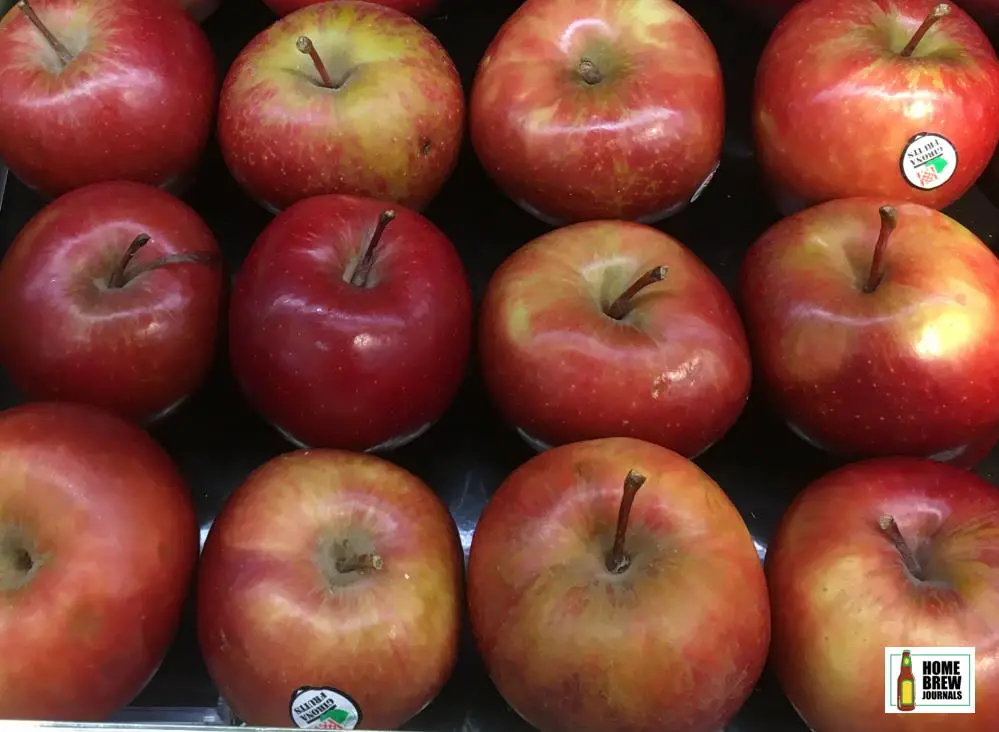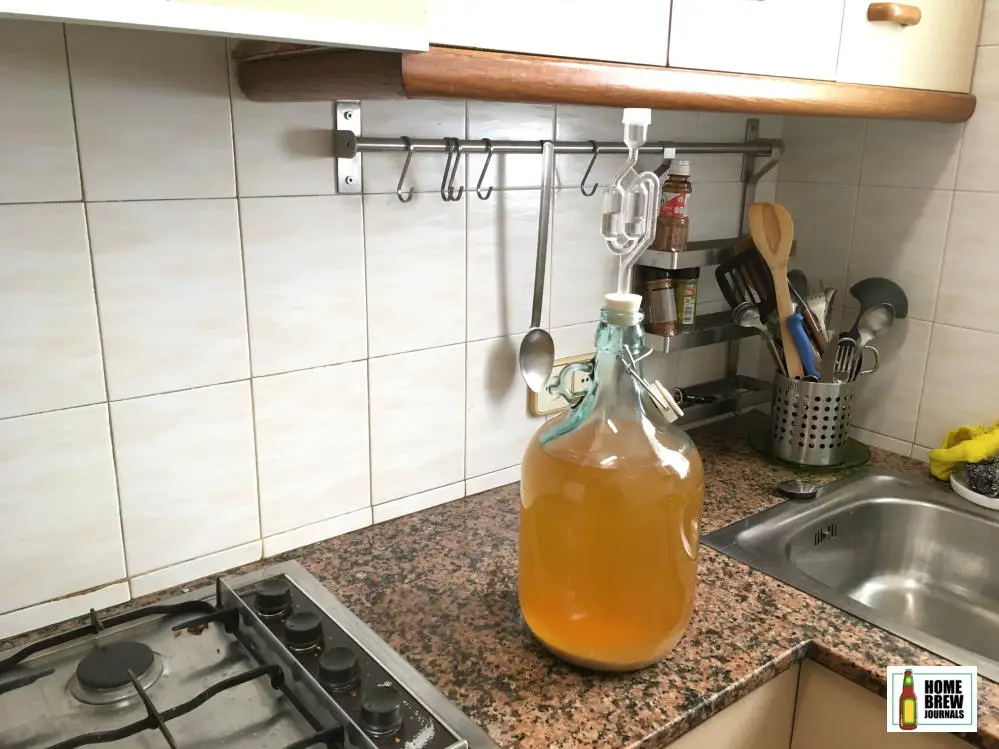Fresh apples are made up of approximately 85% water and 10% fermentable sugar. They also contain yeast which means that to make cider, you simply need to extract the juice and leave it in a clean container away from sunlight to ferment.
Traditional craft cider made using naturally occurring wild yeasts takes two to three months to ferment. Alternatively, cultivated yeast and yeast nutrients may be added in which case fermentation takes about a week. Once fermentation has completed, the cider is racked off to a second vessel to age.
The advantage of using naturally occurring yeast strains is that it gives a more complex flavour to the finished cider. Additionally, since fermentation often stops before all the sugar in the juice has been consumed by the yeast, it may also leave some residual sweetness in the finished cider.

The downside of relying on naturally occurring yeast, apart from the fact that fermentation takes longer, is that it can give unpredictable results. In most cases, after a few weeks, saccharomyces cerevisiae (the yeast used to brew beer) will dominate and kill off undesirable bacteria. However, if things don’t go to plan, you may end up making vinegar.
Because of this, most people who make cider at home use Camden tablets to kill off any bacteria and wild yeast in the juice before adding cultivated yeast. Cider yeast is available at homebrew stores and online, but you can also get good results using wine yeast.
Unlike natural fermentation which may stop before all the sugar from the fruit juice has been consumed by the yeast. Cultivated yeast ferments more vigorously and will continue until it uses up all the available sugar. This produces a very dry tasting cider which may need to be back sweetened by adding either pasteurised apple juice or sugar.
Cider fermentation timeline – Wild yeast
A typical timeline for traditional craft cider production;
Day 1
During October and November apples collected from the orchards are washed, milled and pressed to extract as much juice as possible. The juice is placed in large oak or plastic barrels which are stored in a dark barn.
Week 1 to 2
Fermentation starts slowly as the wild yeast grows, consuming sugars and creating alcohol and CO2.
Months 2 to 3
Fermentation continues slowly, as temperature drops during winter fermentation may almost stop before re-starting in spring as temperatures rise again.
Month 3 to 4
The fermented cider is racked off into a second vessel where it is left to age and mature for several weeks or months.
Month 6 onwards
By late spring or early summer, once the cider has matured, it is ready to be bottled and sold to the public.
Cider fermentation timeline – Cultivated yeast
Most home cider-makers prefer to use cultivated yeast which ferments faster and gives more reliable results. The timeline for making cider at home using apples and cultivated yeast is as follows.
Day 1
Clean, chop and press apples, if you can’t get hold of cider apples, you can use a mixture of cooking and dessert apples.
If you plan to make a lot of cider, you will need to purchase a fruit press, but if you are only making a small one gallon (4 litres) batch, then a juicer will suffice. Just work slowly and make sure you don’t overheat the electric motor.
Transfer the juice into your fermentation vessel and add crushed Camden tablets to kill off bacteria and wild yeast that are present in the apples. Cover the fermenter and leave it in a dark room or cupboard for twenty-four hours.
Day 2
Add yeast nutrient and pitch the yeast. Apple juice contains plenty of sugars, but it doesn’t contain the other nutrients which are present in malts and even grapes. Because of this, to ensure that fermentation gets off to a good start, it’s a good idea to add yeast nutrient.
Put the lid on the fermenter, making sure it seals properly, and add an airlock part filled with water.
Leave the fermenter in a dark place at room temperature for two weeks.
Day 3
Fermentation should start between eight and twenty-four hours after the yeast was added to the juice.
Approximately one week later, you should see that fermentation slows down and stops. Leave the cider in the fermenter for a few more days so that the yeast and apple pulp can settle to the bottom of the fermentation vessel.
Day 14
Bottle the cider in brown bottles and leave in a dark place at room temperature for two weeks to mature.
Day 28
Refrigerate the cider before drinking.

Can you ferment cider too long?
Cultivated yeast will continue to ferment until there is no sugar left in the cider.
If you don’t like dry cider, you can add apple juice or sugar before bottling. This process is called back sweetening.
In addition to sweetening the cider, the sugar causes the leftover yeast to start fermenting again, producing carbon dioxide and naturally carbonating the cider. If you drink the sweetened cider after one to two weeks, it should still be medium-sweet.
Conversely, if you let the sweetened cider ferment for too long, it will continue until all the added sugar has been converted into alcohol. Once again, you will end up with dry cider, albeit with a higher ABV (alcohol content).
The alternative is to either use unfermentable sugar as a sweetener or pasteurise the cider. If you want sparkling, sweet cider, you can back sweeten with juice, bottle, wait approximately four days for carbonation and then pasteurise the bottles.
Cider, scrumpy or hard cider, what’s the difference?
The internet is full of recipes and videos that explain how to make cider, scrumpy and hard cider. In case you’re wondering what the difference is, I thought I’d end this post with a short explanation.
Cider was first fermented by the Ancient Greeks around 3,000 years ago and probably arrived in Britain when the Romans invaded in 84 AD.
The UK’s climate, which is mostly too cool for grapes, is ideal for apple trees and cider soon became the country’s alcoholic drink of choice. By the twelfth century, production was so widespread that it became common for farmworkers to have part of their wages paid in cider.
Cider sold in the UK usually has an ABV of around 5%. Commercially produced cider is often made from concentrated apple juice to which sugar and colourants are added. UK law states that cider must contain at least 35% apple juice and have an ABV between 1.2% and 8.5%.
The word scrumpy refers to traditional craft cider made from nothing but apples, often in the South West of England.
In the USA, fresh unfiltered apple juice is referred to as cider or apple cider. Cider which has been fermented and contains alcohol is called hard cider.
